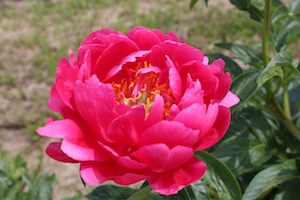|
WHY DON'T MY PEONIES BLOOM? Ways to ensure your peonies bloom.
However, it can be disappointing when peonies fail to bloom, despite that the shoots and roots of the plant seem to be healthy and vigorous. Shade from a tree, shrubs or an adjacent building can affect the bloom production. Peonies require direct, full sun for at least six to eight hours to produce blossoms. If lack of sun is the case, transplant the peonies in September to a new site that receives full sun. Deep planting of peonies can prevent flower bud formation but, interestingly, the plant can still produce beautiful foliage. The eyes of peonies should not be buried more than 2 inches below the soil surface. Recently transplanted or divided peonies can sometimes take two to three years to get re-established in the new site before they start to bloom. Overcrowding of peonies or competition from neighboring plants can also result in less bloom production. Though peonies are heavy feeders, frequent application of nitrogen fertilizer can trigger more leaf production rather than flower bud formation. A balanced fertilizer applied in early spring (before new growth appears) and another application immediately after plants are done blooming can benefit peonies. Be cautious not to fertilize too close to the plant, as the crown can be susceptible to fertilizer burn. Keep the fertilizer at least 6 to 12 inches away from the crown of the plant. There are certain cultivars that can develop buds but may fail to open due to a sudden change in weather conditions, especially hot temperatures. Late frost in May can sometime damage the young flower buds. During cool, wet conditions in spring, botrytis blight disease can occasionally attack the flower buds. Remove any infected flower buds or dead foliages in late fall to minimize the spread of this disease. |
 Peonies are one of the most popular herbaceous perennials that are fairly adaptable, easy to grow and well known for their wonderful floral display.
Peonies are one of the most popular herbaceous perennials that are fairly adaptable, easy to grow and well known for their wonderful floral display.